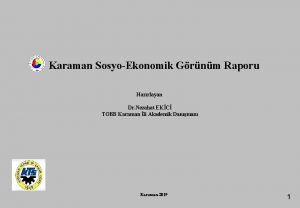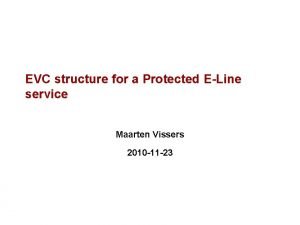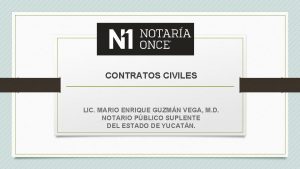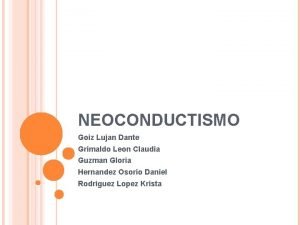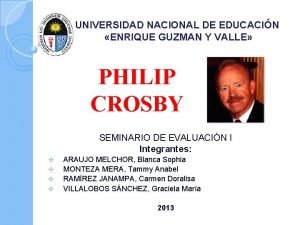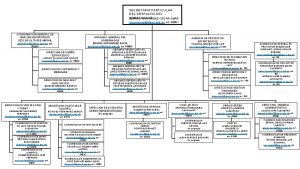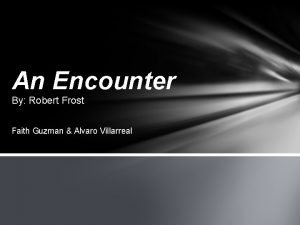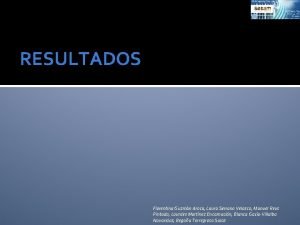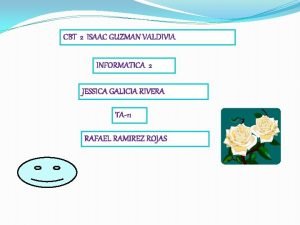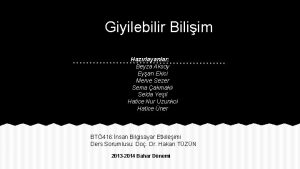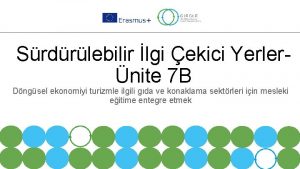MARIA GUZMAN DIDEM EKICI ONLINE EQUITY WORKSHOP PRESENTATION






























- Slides: 30

MARIA GUZMAN DIDEM EKICI ONLINE EQUITY WORKSHOP

PRESENTATION OVERVIEW General Topics: • What is Equity? • Online Equity Rubric • The goal • Components • Practicing Equity Online • Examples: Our experiences as instructors – Canvas content • Post-Workshop: Additional Resources This Photo by Unknown author is licensed under CC BY-SA-NC.

WHAT IS EQUITY? Question 1: How do you define equity? Go to www. menti. com and enter the digit code 63 73 08 OR For workshop attendees: You can click on the link we share in the chat box https: //www. menti. com/a 6 anpknk 5 r For the results: https: //www. mentimeter. com/s/9 b 770 b 572856 bb 62 e 4 f 1127 ffd 230 bd 7/523 b 559 b 7 e 87 Question 2: How do we practice it in online teaching (Canvas)? The Online Equity rubric is a great start. Let's review its design. . .

ONLINE EQUITY RUBRIC • The overall goal of the Peralta CTE Online Equity Initiative is to improve educational equity and outcomes for online CTE students, both at Peralta and at other California community colleges (CCCs). • The rubric is grounded in recent research on equity strategies for college student engagement and lists eight criteria for instructors to use in designing or evaluating an online course. • These criteria were designed to be used in conjunction with, and not separate from, the CVC-OEI Course Design Rubric.

E-5: Images & Representation • The Problem: images or videos can represent some groups of people unequally or promote stereotypes.

Why is it important? • Discrimination in the mainstream media • Create unconscious bias • Negative impact on student success & self esteem https: //perception. org/representation/black-male-re-imagined/

So , how can I make a change? 1 - Review the images and media in your online course https: //peralta. instructure. com/courses/31184/files/1402631/ download? wrap=1 Kevin’s list of sources for images 2 - Discuss Images and Representation in class https: //www. rootinc. com/blog/six-actions-to-mitigate-implicit-bias/ https: //hrasiamedia. com/top-news/2019/stereotyping-is-a-workplace-problem/

NOW, YOUR TURN! Can you tell us what you think might be wrong with this image?

What about this?

E 6: Human Bias

Online Equity in Canvas content • A lack of variety can create an implied preference or model (canon) • Uninformed representation can alienate students as much as negative imagery • If there is a historical lack of diversity in your area of study, how can an assignment address this, for example? Image: Aphrodite and Eros, Roman, early 2 nd century AD, marble - Galleria Borghese - Rome, Italy – Wikimedia Commons

E 6: Human Bias • Biases can be about learning style, technical savvy, writing style, late posting to discussions, attendance, gender, race, and ethnicity. • What is a classroom practice that you have adopted recently, which was the result of addressing a bias? Were you embarrassed/shocked to have a bias about students or their behavior in the class? • Canvas advantage: Asynchronous course content can enable working students to "attend" courses – not tied to time or place. • Canvas challenge: Addressing bias and creating safe spaces in LMS online

Create Content = Challenge Bias Power dynamics can be implicit biases in teaching & learning environments – aim to dispel these with humor, encouragement, and personalized narratives/examples. Add your Diversity Statement to the course content (Week 1 recommended). Here's mine – Diversity Statement 2019. Feel free to take the document and use/edit it for your own statement. Reconsider standard assignments – what is the success rate or completion rate? Do you utilize a broad selection of topics & images?

"Create syllabus and curriculums that are innovative – there are more ways to assess work than the research essay, but do not use this as a short cut to not help marginalized students with academic work. "("Do Not ‘Decolonize'. . . If You Are Not Decolonizing: Progressive Language and Planning Beyond a Hollow Academic Rebranding

Dispelling Power Dynamics: How do you stay approachable online? • Add a profile picture to your Canvas account (go to Settings) • Video and sound recordings enable you to express emotion more fully – share something relatable • Keep notes (index card) on students, adding details as you learn about their online experiences in class Resource: Flipgrid – class introduction: https: //flipgrid. com/s/cb 1 d 978 b 4 c 3 d • Profile picture with cat recommended

E 7: Content Meaning

E 7: Content Meaning • Small but effective measures: Diversity Flag – Wikimedia Commons • I add it near my instructor contact info in syllabus & Canvas page • Use content that SPEAKS TO YOU! • I like to take time to explain the very first time that I saw a Goya, a Kahlo, and a Christo & Jean-Claude artwork = meaningful Description The image is of a flag representing the celebration of diversity, of people and cultures. • I also discuss the problematic nature of Guaguin's works, and am honest about my conflicting feelings about his art = encourage critical thinking and development of authentic responses to content • Accept many perspectives – avoid the "one correct answer" trap

Revise your syllabus & materials Equitable practices in teaching: Source: "Do Not 'Decolonize'. . . If You Are Not Decolonizing: Progressive Language and Planning Beyond a Hollow Academic Rebranding. " • Decentre knowledge and knowledge production – open pedagogy • Diversify your syllabus and curriculum • Digress from the canon • Devalue hierarchies • Disinvest from citational power structures

E-8 Connection & Belonging • The "Connection & Belonging" criterion is related to meeting some of our students' social and psychological needs.

Connection & Belonging: Meeting social needs by creating connection: Interaction. . . • with the instructor • with the course content • with their peers are the key points here. https: //padlet. com

Connection & Belonging: Meeting psychological needs by fostering a sense of belonging: • Promoting the feelings of being accepted, respected, included, and supported by others https: //elearningindustry. com/google-classroom-review-pros-and-cons-of-using-googleclassroom-in-elearning https: //www. npr. org/2020/03/06/812462913/6 -ways-universities-are-responding-tocoronavirus

Why is it important to make connections? Available & communicative instructor Better student experience and learning https: //www. gettingsmart. com/2016/09/changing-university-culture-to-transform-the-student-experience/ Instructor's lack of responsiveness and caring Feelings of isolation https: //www. weareteachers. com/7 -ways-to-help-students-who-struggle-with-anxiety/

What can we do? • Humanizing the online environment is crucial. Created by Michelle Pacansky-Brock Sources for video making https: //www. wevideo. com/ https: //info. flipgrid. com/ https: //support. apple. com/en-us/HT 201066

Some Ideas. . .

You can use some softwares to reflect: Padlet

THANK YOU! • Keep in touch! If you have questions or want to share ideas, readings, etc. -- please do : ) mguzman@peralta. edu dekici@peralta. edu Get Involved with our Team: Contact istark@peralta. edu

ADDITIONAL RESOURCES & READING • Appleton, Nayantara Sheoran. "Do Not 'Decolonize'. . . If You Are Not Decolonizing: Progressive Language and Planning Beyond a Hollow Academic Rebranding. " 4 February 2019. Critical Ethnic Studies. http: //www. criticalethnicstudiesjournal. org/blog/2019/1/21/do-not-decolonize-if-you -are-not-decolonizing-alternate-language-to-navigate-desires-for-progressive-academia-6 y 5 sg, accessed 29 March 2020. • Baker, R. , Dee, T. , Evans, B. & John, J. (March 2018). "Biases in Online Classes: Evidence from a Field Experiment. " Stanford/Institute for Economic Policy Research (SIEPR). https: //siepr. stanford. edu/sites/default/files/publications/18 -055. pdf, accessed 28 March 2020. • De. Chavez, Yvette. "It's Time to Decolonize Your Syllabus. " 8 October 2018. The Los Angeles Times. https: //www. latimes. com/books/la-et-jc-decolonize-syllabus-20181008 -story. html, accessed 29 March 2020.

ONLINE EQUITY TRAINING • teaches faculty about equity issues within the CCC system and leads instructors through a step-by-step process of how to use the rubric to infuse equity principles into their online courses.

ONLINE EQUITY TRAINING • Totally online • 5 -week long • Helps you align your course(s) with OER • Based on theories, analysis and practice • The coursework should take roughly 5 -7 hours per week, and you will have two assignments to complete with two different weekly deadlines. • In order to pass the course, you will need to receive an 80% or better on each of the assignments.

COURSE OVERVIEW Week 1: Getting Started & Discussing Equity and Our Courses Week 2: E 1 and E 2: Focus on Technology and Student Resources & Support Week 4: E 5 and E 6: Focus on Images & Representation and Human Bias Week 5: E 7 and E 8: Focus on Content Meaning and Connection & Belonging Week 3: E 3 and E 4: Focus on Universal Design and Diversity & Inclusion
 Didem ekici
Didem ekici Nezahat ekici
Nezahat ekici Cemre ekici bayram
Cemre ekici bayram Didem evci kiraz
Didem evci kiraz Juf didem
Juf didem Frederick rowe
Frederick rowe Didem caran
Didem caran Didem mies
Didem mies Oración a santo domingo de guzmán
Oración a santo domingo de guzmán Dr peralta angiologo cd guzmán
Dr peralta angiologo cd guzmán Sally guzman edmonds school district
Sally guzman edmonds school district Teoría alemana del acto jurídico
Teoría alemana del acto jurídico Claudia guzman biografia
Claudia guzman biografia Universidad enrique guzman y valle
Universidad enrique guzman y valle Oscar omar bernal hernández
Oscar omar bernal hernández Abigael guzman muerte
Abigael guzman muerte Kasukdulan
Kasukdulan Faith guzman
Faith guzman Fillipeans
Fillipeans Florentina guzman aroca
Florentina guzman aroca Clara guzman zapater
Clara guzman zapater Gloria guzman ospina
Gloria guzman ospina Manuel guzman
Manuel guzman Onel de guzman wiki
Onel de guzman wiki Cbt 2 isaac guzman valdivia
Cbt 2 isaac guzman valdivia Sigit
Sigit Private equity lbo case study
Private equity lbo case study Cpt online workshop umich
Cpt online workshop umich Words their way online workshop
Words their way online workshop Business strategy workshop presentation
Business strategy workshop presentation Business continuity presentation
Business continuity presentation

